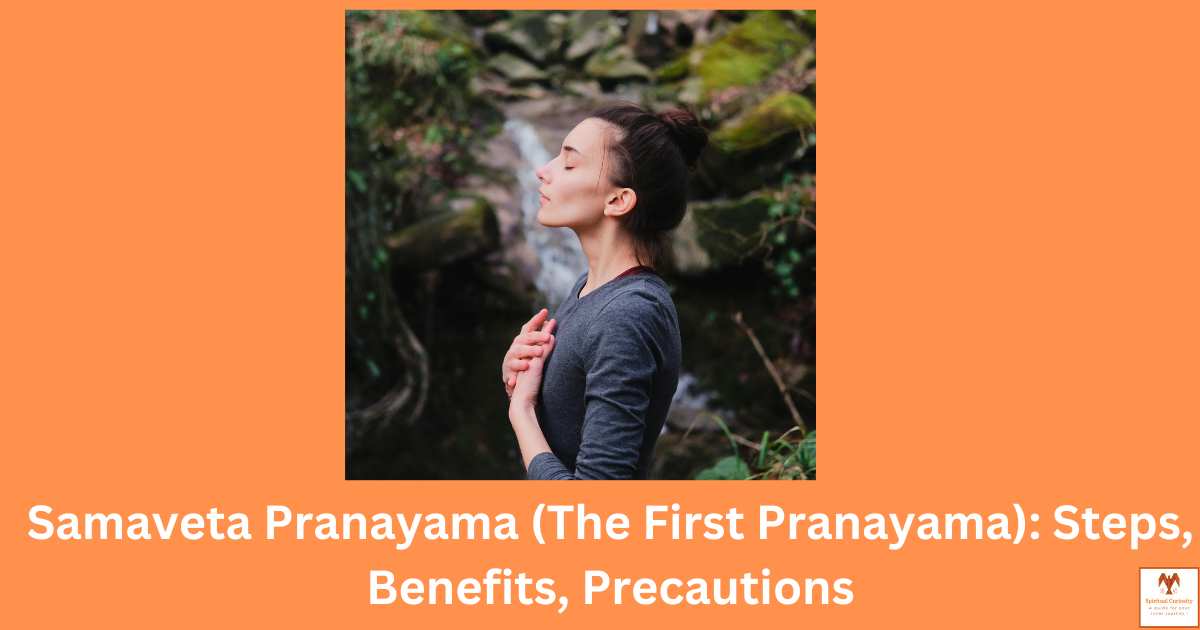Samaveta Pranayama, a delightful and straightforward practice of pranayama where you get to breathe through both nostrils simultaneously.
The word “samaveta” comes from Sanskrit, meaning “together.” It’s a fantastic technique that is often described as simple and easy to perform.
Many sources highlight this technique as a foundational practice in the world of pranayama.
In fact, it serves as a perfect warm-up for more advanced pranayama practices, preparing your mind and body for the incredible journey ahead.
So, take a deep breath and get ready to explore the harmonious union of both nostrils in Samaveta Pranayama. Let the energy flow and embrace the simplicity of this beautiful practice.
Pranayama and Energy Balance
In the practice of pranayama, there are various forms of energy within us that are closely connected to our health, thinking, and reactions to the external world.
These energies, known as pranas, can be both subtle and gross.
While some forms of energy, such as nervous energy and chemical energy, are well-known, there are others that are not commonly perceived in everyday life.
Pranayama aims to harmonize and manipulate these energies, with the control and manipulation of respiration playing a key role.
Mention in Scriptures
The scriptures of yoga, such as the Yoga Sutras of Patanjali, mention pranayama as an essential practice for harnessing and channeling pranic energy.
“tataḥ kṣīyate prakāśāvaraṇaṁ” (Yoga Sutra 2.52)
Translation: “From that, the veil covering the inner light is diminished.”
This verse, found in Patanjali’s Yoga Sutras, specifically in Book 2 (Sadhana Pada), Verse 52, suggests that through the practice of pranayama, the obstacles or veils that hinder our inner light, clarity, and spiritual growth are gradually reduced.
It emphasizes the transformative power of pranayama in removing the layers that obstruct our true nature.
Samaveta Pranayama Steps/Procedure
- Sit in a comfortable position, preferably in one of the meditative asanas.
- If meditative asanas are uncomfortable, you can sit in a chair or against a wall with your feet outstretched. Ensure that your spine remains erect.
- Close your eyes.
- Start practicing yogic breathing, focusing on making the movement of the abdomen and chest as rhythmical as possible. Inhale with a wavelike motion from the abdomen to the chest and exhale with a wavelike motion from the chest to the abdomen. Breathe deeply without straining, expelling and inhaling the maximum amount of air.
- Keep your eyes closed throughout the practice and continue this breathing pattern for a few minutes.
- Begin the practice of samaveta pranayama: At the end of inhalation, hold the breath for a second or so without straining, then breathe out. Ensure that your breathing remains slow and comfortable.
- Exhale as much air as possible, then inhale. Again, hold the breath for a short time and exhale. Repeat this cycle for the duration of your practice session.
- Duration of retention: Over a period of weeks, gradually increase the time of breath retention from a second or so up to a maximum of ten seconds. It is important not to hold the breath for longer than what is comfortable. With regular practice, the time of breath retention will naturally increase.
Duration
Start with a short duration, such as 5 minutes, and gradually increase it based on your comfort and progress. The duration of practice can be extended to suit your individual capacity and needs.
Time of Practice
Samaveta pranayama can be practiced at any time of the day, preferably on an empty stomach. However, it is generally recommended to practice pranayama in the early morning or evening when the body and mind are relatively calm.
Samaveta Pranayama Precautions
- It is important to practice samaveta pranayama under the guidance of a qualified yoga instructor, especially if you are new to pranayama or have any respiratory or cardiovascular conditions.
- Avoid straining or forcing the breath during the practice. Maintain a comfortable and natural pace of breathing.
- If you experience any dizziness, discomfort, or shortness of breath, stop the practice and consult a yoga instructor or healthcare professional.
- Ensure that the practice environment is clean, well-ventilated, and free from distractions.
Samaveta Pranayama Benefits
- Preparation for advanced pranayama practices: Samaveta pranayama helps prepare the lungs for more advanced pranayama techniques.
- Increased oxygen exchange: During breath retention in samaveta pranayama, the exchange of oxygen between the blood and the lungs, as well as the discharge of carbon dioxide between the lungs and the blood increases.
- Calming and balancing effect: The rhythmic breathing pattern of samaveta pranayama promotes a sense of calmness and balance in the mind and body.
- Improved respiratory function: Regular practice of samaveta pranayama strengthens the respiratory muscles, enhances lung capacity, and improves overall respiratory function.
- Enhanced energy flow: By harmonizing and manipulating the subtle and gross forms of energy (pranas), samaveta pranayama helps to optimize the flow of energy within the body, leading to increased vitality and overall well-being.
- Stress relief: The deep and conscious breathing involved in samaveta pranayama activates the parasympathetic nervous system, promoting relaxation, reducing stress, and improving mental clarity.
- Detoxification: The increased exchange of oxygen and carbon dioxide during breath retention aids in the elimination of toxins from the body, supporting the detoxification process.
- Mind-body connection: Samaveta pranayama cultivates a deeper awareness of the breath and enhances the connection between the mind and body, fostering a state of mindfulness and inner harmony.
Learn everything about various pranyamas from authentic sources.
References
- Book: Asana Pranayama Mudra Bandha by Swami Satyananda Saraswati
- Book: The science Of Pranayama by Sri Sivananda.
- Book: Light on Pranayama by B.K.S Iyengar.

My brother suggested I might like this website He was totally right This post actually made my day You cannt imagine just how much time I had spent for this information Thanks